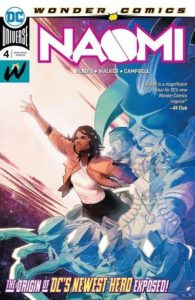 Naomi #4 — Writer: Brian Michael Bendis; Art/Colors: Jamal Campbell
Naomi #4 — Writer: Brian Michael Bendis; Art/Colors: Jamal Campbell
Pearl #8 — Writer: Brian Michael Bendis; Art/Colors: Michael Gaydos
Batman #69 — Writer: Tom King; Art: Yanick Paquette; Colors: Nathan Fairbairn
Brian Bendis’s move to DC has to be considered a success — everything he’s written so far has been solidly entertaining, from the Superman books to the creator-owned stuff to the YA “Wonder Comics” imprint. Naomi is part of that, and of the regular DC universe too, and apparently will tie in to ongoing  continuity — so much so that speculators (them again) have driven up the price of earlier issues considerably (if you don’t have issues 1-3 now, you’re going to need to wait for the inevitable reprints — or the trade collection). This week’s issue begins her origin, with the usual Bendis-scripted realistic parent/child dialogue and relationship — except that both her parents and she turn out to be more than the small-town regular folk than they seem (no spoilers, although I will say that it’s apparently driven the price of Blackest Night #7 up…). Pearl isn’t DC-connected; it’s part of Bendis’s creator-owned Jinxworld imprint, and it continues to feature a pyrotechnic action-movie plot (she’s a tattoo artist/reluctant Yakuza assassin) and absolutely stunning
continuity — so much so that speculators (them again) have driven up the price of earlier issues considerably (if you don’t have issues 1-3 now, you’re going to need to wait for the inevitable reprints — or the trade collection). This week’s issue begins her origin, with the usual Bendis-scripted realistic parent/child dialogue and relationship — except that both her parents and she turn out to be more than the small-town regular folk than they seem (no spoilers, although I will say that it’s apparently driven the price of Blackest Night #7 up…). Pearl isn’t DC-connected; it’s part of Bendis’s creator-owned Jinxworld imprint, and it continues to feature a pyrotechnic action-movie plot (she’s a tattoo artist/reluctant Yakuza assassin) and absolutely stunning  art from Michael Gaydos; out of the 25 or so comics I got this week, it was the first one I read. Batman was close — it finally finishes the “Batman’s Knightmares” sequence where a sedated and captured Caped Crusader has fitful dreams; last issue’s was a romp about Catwoman and Lois Lane’s bachelorette party, while this one’s, more serious, has Selina and Bruce dancing, as his subconscious works through their relationship. King’s been impressive with his character and psyche-related stuff, and there’s genuine pathos here; for outright superhero action, there’s some sparring between Bane and a Batman — and wait until next issue, as the plot accelerates into the final third of King’s 100-issue run.
art from Michael Gaydos; out of the 25 or so comics I got this week, it was the first one I read. Batman was close — it finally finishes the “Batman’s Knightmares” sequence where a sedated and captured Caped Crusader has fitful dreams; last issue’s was a romp about Catwoman and Lois Lane’s bachelorette party, while this one’s, more serious, has Selina and Bruce dancing, as his subconscious works through their relationship. King’s been impressive with his character and psyche-related stuff, and there’s genuine pathos here; for outright superhero action, there’s some sparring between Bane and a Batman — and wait until next issue, as the plot accelerates into the final third of King’s 100-issue run.
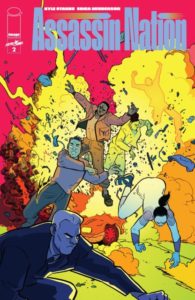 Assassin Nation #2 (of 6?) — Writer: Kyle Starks; Art/Colors: Erica Henderson
Assassin Nation #2 (of 6?) — Writer: Kyle Starks; Art/Colors: Erica Henderson
Little Bird #2 (of 5) — Writer: Darcy van Poelgeest; Art: Ian Bertram; Colors: Matt Hollingsworth
B.P.R.D.: The Devil You Know #15 (of 15) — Writers: Mike Mignola and Scott Allie; Art: Laurence Campbell and Mike Mignola; Colors: Dave Stewart
Lumberjanes #61 — Writers: Shannon Watters and Kat Leyh; Art: AnneMarie Rogers; Colors: Maarta Laiho
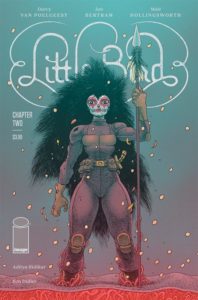 Assassin Nation is about the world’s best assassin (they have a ratings system, just like tennis and chess), who’s got a contract out on him, and hires a bunch of other top assassins to stop it. You might think that Erica Henderson, best known for Squirrel Girl, wouldn’t be the right artist for this, but she absolutely is: she talks in the editorial material about how she and writer Kyle Starks share a love for action and horror films, and their obvious enthusiasm is infectious; not only that, but she has a couple scenes where she has to communicate character emotions only by the art, and she nails every one. If you like B-movie shoot-’em-ups, or comics like Robert
Assassin Nation is about the world’s best assassin (they have a ratings system, just like tennis and chess), who’s got a contract out on him, and hires a bunch of other top assassins to stop it. You might think that Erica Henderson, best known for Squirrel Girl, wouldn’t be the right artist for this, but she absolutely is: she talks in the editorial material about how she and writer Kyle Starks share a love for action and horror films, and their obvious enthusiasm is infectious; not only that, but she has a couple scenes where she has to communicate character emotions only by the art, and she nails every one. If you like B-movie shoot-’em-ups, or comics like Robert 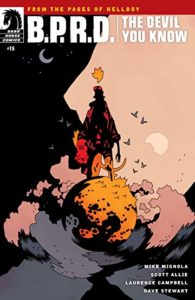 Kirkman’s Die!Die!Die!, you’ll love this too. Little Bird is a dystopian-future tale about a North America over-run with religious fundamentalists, and the small resistance that a young girl both encounters and fuels. It’s another comic whose strongest suit is its art; Ian Bertram has an exaggerated ligne claire style mixed with Japanese influences — a marriage of Moebius and manga — that looks like nobody else, and he has plenty of tyrants, reluctant heroes and spirit dreams to splurge it on here. B.P.R.D. comes to a conclusion after 161 issues — and so does the entire Hellboy universe, as a book that’s always
Kirkman’s Die!Die!Die!, you’ll love this too. Little Bird is a dystopian-future tale about a North America over-run with religious fundamentalists, and the small resistance that a young girl both encounters and fuels. It’s another comic whose strongest suit is its art; Ian Bertram has an exaggerated ligne claire style mixed with Japanese influences — a marriage of Moebius and manga — that looks like nobody else, and he has plenty of tyrants, reluctant heroes and spirit dreams to splurge it on here. B.P.R.D. comes to a conclusion after 161 issues — and so does the entire Hellboy universe, as a book that’s always 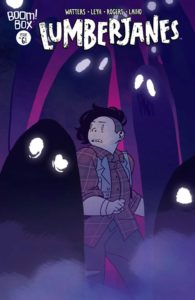 had apocalyptic overtones gets to an actual Ragnarok. Mike Mignola himself draws the last 13 pages, and if you were ever a fan of Hellboy or any of the other cast here, get this to say a proper, and grateful, goodbye. Last, but not least, Lumberjanes begins a new arc as Mal gets advice on how not to be scared during the group’s admittedly-often-scary adventures; that’s a relatable plot, especially for the younger readers who are this comic’s target audience, and as always it’s handled with action, canny characterization, wisdom and magic: all the things that have made this book such a dependedly-charming read for over five years in a crowded comics market.
had apocalyptic overtones gets to an actual Ragnarok. Mike Mignola himself draws the last 13 pages, and if you were ever a fan of Hellboy or any of the other cast here, get this to say a proper, and grateful, goodbye. Last, but not least, Lumberjanes begins a new arc as Mal gets advice on how not to be scared during the group’s admittedly-often-scary adventures; that’s a relatable plot, especially for the younger readers who are this comic’s target audience, and as always it’s handled with action, canny characterization, wisdom and magic: all the things that have made this book such a dependedly-charming read for over five years in a crowded comics market.
 War of the Realms #2 (of 6) — Writer: Jason Aaron; Art: Russell Dauterman; Colors: Matthew Wilson
War of the Realms #2 (of 6) — Writer: Jason Aaron; Art: Russell Dauterman; Colors: Matthew Wilson
Thor #12 (Legacy #718) — Writer: Jason Aaron; Art/Colors: Mike del Mundo
War of the Realms: War Scrolls #1 (of 3) — Creators: Various
War of the Realms: The Punisher #1 (of 3) — Writer: Gerry Duggan; Pencils: Marcelo Ferreira; Inks: Roberto Poggi; Colors: Rachelle Rosenberg
 War of the Realms is a crossover event that writer Jason Aaron’s been building in Thor for a couple of years, involving bad-guy elf Malekith slowly conquering all the Norse-cosmology dimensions: Hel; the one with the frost giants; the one with the fire demons; etc.; now all that’s left is our own Earth, so the invading soldiers and monsters and various beasties have all dimension-hopped in, and are battling the heroes. This week’s issue is the second of six, so obviously things don’t go well (no one wants the last four issues to be everyone standing around at the easy-victory afterparty, although I’d pay for it if Kieron Gillen and Jamie McKelvie did it…); in fact, Earth falls, and we get a number of scenes of different battlefronts and character combinations and tragedies.
War of the Realms is a crossover event that writer Jason Aaron’s been building in Thor for a couple of years, involving bad-guy elf Malekith slowly conquering all the Norse-cosmology dimensions: Hel; the one with the frost giants; the one with the fire demons; etc.; now all that’s left is our own Earth, so the invading soldiers and monsters and various beasties have all dimension-hopped in, and are battling the heroes. This week’s issue is the second of six, so obviously things don’t go well (no one wants the last four issues to be everyone standing around at the easy-victory afterparty, although I’d pay for it if Kieron Gillen and Jamie McKelvie did it…); in fact, Earth falls, and we get a number of scenes of different battlefronts and character combinations and tragedies. 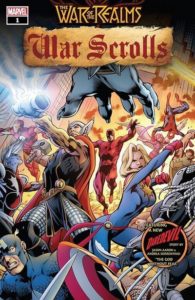 Russell Dauterman’s art is an attraction: his disoriented panel compositions are subtle echoes of the chaos of battle, and his precise character and costume choices (involving dozens of humans, gods and mythological races) propel the narrative clearly, despite all the crosscutting. After you’ve read the main title, three other books spotlight different aspects of the battle: Thor itself, also by Aaron, is about the plight of Loki, who’s been swallowed whole by his frost-giant father and now is confronting his former selves while slowly dissolving in dad’s stomach acid (something you really don’t see every day…); Mike del Mundo’s painted art, somehow simultaneously delicate and lurid, conveys the fairy-tale tone perfectly. War of the Realms: War Scrolls is an anthology book with four different short tales, all set in the main battleground of NYC: Aaron and Andrea Sorrentino show Malekith putting his base in Hell’s
Russell Dauterman’s art is an attraction: his disoriented panel compositions are subtle echoes of the chaos of battle, and his precise character and costume choices (involving dozens of humans, gods and mythological races) propel the narrative clearly, despite all the crosscutting. After you’ve read the main title, three other books spotlight different aspects of the battle: Thor itself, also by Aaron, is about the plight of Loki, who’s been swallowed whole by his frost-giant father and now is confronting his former selves while slowly dissolving in dad’s stomach acid (something you really don’t see every day…); Mike del Mundo’s painted art, somehow simultaneously delicate and lurid, conveys the fairy-tale tone perfectly. War of the Realms: War Scrolls is an anthology book with four different short tales, all set in the main battleground of NYC: Aaron and Andrea Sorrentino show Malekith putting his base in Hell’s  Kitchen, turning Daredevil into a resistance fighter (another story with imaginative panel layouts); there’s also a Warriors Three tale by Josh Trujillo and Ricardo Lopez Ortiz, a Wolverine/Punisher semi-team-up by Ram V. and Cafu, and, as a chaser, a four-pager giving the invasion from the perspective of Howard the Duck, by Chip Zdarsky and Joe Quinones: a decent mix of creators for your $4.99. Speaking of the Punisher, he gets his own WOTR mini-series, as he has to shepherd a number of injured refugees through a monster-infested Lincoln Tunnel to the dubious safety of New Jersey; if you like the cover, with Frank sending a bunch of ordinance down the gullet of a frost giant, then there’s a lot more of it on the inside….
Kitchen, turning Daredevil into a resistance fighter (another story with imaginative panel layouts); there’s also a Warriors Three tale by Josh Trujillo and Ricardo Lopez Ortiz, a Wolverine/Punisher semi-team-up by Ram V. and Cafu, and, as a chaser, a four-pager giving the invasion from the perspective of Howard the Duck, by Chip Zdarsky and Joe Quinones: a decent mix of creators for your $4.99. Speaking of the Punisher, he gets his own WOTR mini-series, as he has to shepherd a number of injured refugees through a monster-infested Lincoln Tunnel to the dubious safety of New Jersey; if you like the cover, with Frank sending a bunch of ordinance down the gullet of a frost giant, then there’s a lot more of it on the inside….
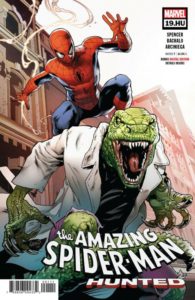 Amazing Spider-Man #19.HU — Writer: Nick Spencer; Pencils: Chris Bachalo; Inks: Wayne Faucher, Livesay, Jaime Mendoza, Victor Olazaba, Tim Townsend and Al Vey; Colors: Erick Arciniega
Amazing Spider-Man #19.HU — Writer: Nick Spencer; Pencils: Chris Bachalo; Inks: Wayne Faucher, Livesay, Jaime Mendoza, Victor Olazaba, Tim Townsend and Al Vey; Colors: Erick Arciniega
Spider-Man: Life Story #2 (of 6) — Writer: Chip Zdarsky; Pencils: Mark Bagley; Inks: Drew Hennessy; Colors: Frank D’Armata
Miles Morales: Spider-Man #5 (Legacy #245) — Writer: Saladin Ahmed; Art: Javier Garron; Colors: David Curiel
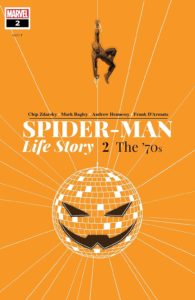 Spider-Man: City at War #2 (of 6) — Writer: Dennis “Hopeless” Hallum; Art: Michele Bandini; Colors: David Curiel
Spider-Man: City at War #2 (of 6) — Writer: Dennis “Hopeless” Hallum; Art: Michele Bandini; Colors: David Curiel
Amazing Spider-Man #252 Facsimile Edition #1 (of 1) — Plot: Roger Stern; Script: Tom Defalco; Pencils: Ron Frenz; Finishes: Brett Breeding; Colors: Glynis Wein
With everyone talking about The Avengers: Endgame, it’s easy to forget that this summer also will see a new live-action Spider-Man film; Marvel hasn’t forgotten, though, and they’re priming the pump with five different arachno-titles this week. Amazing Spider-Man #19.HU is an  “extra” issue of that title’s current Kraven the Hunter-centric “Hunted” story, spotlighting Curt Conners, the Lizard; you want it because it’s drawn by Chris Bachalo, who’s contributed a number of previous stories involving Spidey’s saurian adversary, and gets such obvious pleasure out of drawing him that readers can’t help but be happy, too. Spider-Man: Life Story is a mini-series imagining a world where Peter Parker, after being bit by that radioactive spider in 1962, aged in real time; this issue looks at the 1970s, so various Osborns, plus Professor Miles Warren and his clonal obsessions, play major roles, as do both Gwen Stacy and Mary Jane Watson. It’s basically a big ol’ What If? story, and if you’re up on Spidey continuity,
“extra” issue of that title’s current Kraven the Hunter-centric “Hunted” story, spotlighting Curt Conners, the Lizard; you want it because it’s drawn by Chris Bachalo, who’s contributed a number of previous stories involving Spidey’s saurian adversary, and gets such obvious pleasure out of drawing him that readers can’t help but be happy, too. Spider-Man: Life Story is a mini-series imagining a world where Peter Parker, after being bit by that radioactive spider in 1962, aged in real time; this issue looks at the 1970s, so various Osborns, plus Professor Miles Warren and his clonal obsessions, play major roles, as do both Gwen Stacy and Mary Jane Watson. It’s basically a big ol’ What If? story, and if you’re up on Spidey continuity, 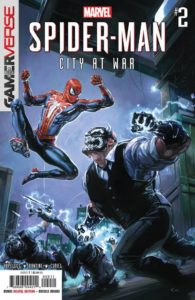 you’ll appreciate all its call-backs and Easter eggs. Miles Morales: Spider-Man follows that younger, more-diverse version of the Webspinner; as its lighthearted one-shot Ferris Bueller parody last issue showed, it’s got an appealing breeziness in tone, like a late-’70s or early-’80s Spectacular Spiderman, but with a middle-teen cast instead of a twentysomething-college-campus one. It begins a new serial involving Tombstone (who’s on the cover, just up to the left there, but never actually appears in any scene like that in the book — a pet peeve…) and a new teen heroine: not a bad jumping-on opportunity. Spider-Man: City At War is a videogame adaptation; like most of those, it works better if you’ve actually played the game — watching events that played out on your game screen unfold on the page is more fun than being a non-gamer and wondering why all these people are acting
you’ll appreciate all its call-backs and Easter eggs. Miles Morales: Spider-Man follows that younger, more-diverse version of the Webspinner; as its lighthearted one-shot Ferris Bueller parody last issue showed, it’s got an appealing breeziness in tone, like a late-’70s or early-’80s Spectacular Spiderman, but with a middle-teen cast instead of a twentysomething-college-campus one. It begins a new serial involving Tombstone (who’s on the cover, just up to the left there, but never actually appears in any scene like that in the book — a pet peeve…) and a new teen heroine: not a bad jumping-on opportunity. Spider-Man: City At War is a videogame adaptation; like most of those, it works better if you’ve actually played the game — watching events that played out on your game screen unfold on the page is more fun than being a non-gamer and wondering why all these people are acting 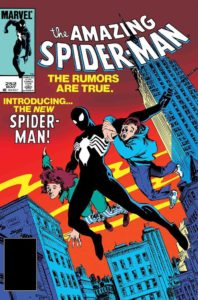 differently, and how this could possibly fit into regular continuity. Finally, Amazing Spider-Man #252 Facsimile Edition is just that, an exact reproduction of the comic that first featured Spider-Man’s new alien costume (not that anyone would know that it was an actual alien for a while…); it’s a good time-capsule example of early-’80s Jim Shooter-era Marvel, and its foreshadowing of the company’s first big crossover, Secret Wars (while it acts like the events in that series have already happened, it actually came out the same month as Secret Wars #1), is fascinating, considering the way those events have echoed over the last 35 years of Marvel history .
differently, and how this could possibly fit into regular continuity. Finally, Amazing Spider-Man #252 Facsimile Edition is just that, an exact reproduction of the comic that first featured Spider-Man’s new alien costume (not that anyone would know that it was an actual alien for a while…); it’s a good time-capsule example of early-’80s Jim Shooter-era Marvel, and its foreshadowing of the company’s first big crossover, Secret Wars (while it acts like the events in that series have already happened, it actually came out the same month as Secret Wars #1), is fascinating, considering the way those events have echoed over the last 35 years of Marvel history .
 Avengers: No Road Home #10 (of 10) (Legacy #717) — Writers: Mark Waid, Jim Zub and Al Ewing; Art: Sean Izaakse; Colors: Marcio Menyz with Erick Arciniega
Avengers: No Road Home #10 (of 10) (Legacy #717) — Writers: Mark Waid, Jim Zub and Al Ewing; Art: Sean Izaakse; Colors: Marcio Menyz with Erick Arciniega
True Believers: Avengers — Endgame #1 (of 1) — Writer: Roy Thomas; Pencils: Sal Buscema; Inks: Sam Granger
True Believers: Avengers — The Gatherers Saga #1 (of 1) — Writer: Bob Harras; Pencils: Steve Epting; Inks/Colors: Tom Palmer
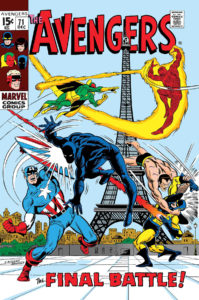 True Believers: Avengers — Thanos: The Final Battle #1 (of 1) — Writer: Jim Starlin; Pencils: Ron Lim; Inks: Josef Rubenstein; Max Scheele and Evelyn Stein
True Believers: Avengers — Thanos: The Final Battle #1 (of 1) — Writer: Jim Starlin; Pencils: Ron Lim; Inks: Josef Rubenstein; Max Scheele and Evelyn Stein
Avengers: No Road Home concludes with its villain being defeated by… creativity; it’s reminiscent of co-writer Mark Waid’s classic Fantastic Four story where the FF went to heaven and God turned out to be Jack Kirby, and worth a 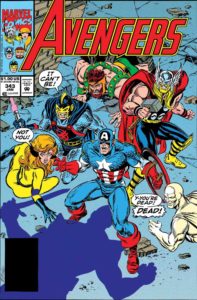 look both because it’s a satisfying end to the story, and to see where it leaves all the main characters; considering its success, look for even more of these weekly mini-series events. We also get three more $1 “True Believers” Avengers books: first is Avengers #71’s first appearance of the Invaders, as the Grandmaster has the book’s time-tossed crew battle the original Human Torch, Captain America and Sub-Mariner during WW II;
look both because it’s a satisfying end to the story, and to see where it leaves all the main characters; considering its success, look for even more of these weekly mini-series events. We also get three more $1 “True Believers” Avengers books: first is Avengers #71’s first appearance of the Invaders, as the Grandmaster has the book’s time-tossed crew battle the original Human Torch, Captain America and Sub-Mariner during WW II;  Roy Thomas and Sal Buscema show exactly what made a decent Marvel comic back in 1969. Compare it to Avengers #343’s story from 23 years later: just the middle section of an ongoing story, with Bob Harras showing nowhere near the writing chops of Thomas — but the very nice-looking Steve Epting/Tom Palmer art making it more than worth the buck anyway. There’s also Avengers: Thanos — the Final Battle, which is actually the conclusion of the Infinity Gauntlet mini-series; here, your dollar buys both a double-size issue and possible clues to how the Avengers movie will resolve its own Gauntlet and Thanos-centric plot.
Roy Thomas and Sal Buscema show exactly what made a decent Marvel comic back in 1969. Compare it to Avengers #343’s story from 23 years later: just the middle section of an ongoing story, with Bob Harras showing nowhere near the writing chops of Thomas — but the very nice-looking Steve Epting/Tom Palmer art making it more than worth the buck anyway. There’s also Avengers: Thanos — the Final Battle, which is actually the conclusion of the Infinity Gauntlet mini-series; here, your dollar buys both a double-size issue and possible clues to how the Avengers movie will resolve its own Gauntlet and Thanos-centric plot.
 Guardians of the Galaxy #4 (Legacy #154) — Writer: Donny Cates; Art: Geoff Shaw; Colors: David Curiel
Guardians of the Galaxy #4 (Legacy #154) — Writer: Donny Cates; Art: Geoff Shaw; Colors: David Curiel
Meet the Skrulls #3 (of 5) — Writer: Robbie Thompson; Art: Niko Henrichon; Colors: Henrichon with Laurent Grossat
Major X #2 (of 6) — Writer: Rob Liefeld; Pencils: Brent Peeples; Inks: Scott Hanna; Colors: Romulo Fajardo Jr.
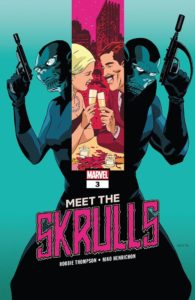 Daredevil #4 (Legacy #616) — Writer: Chip Zdarsky; Art: Marco Checchetto; Colors: Sunny Gho
Daredevil #4 (Legacy #616) — Writer: Chip Zdarsky; Art: Marco Checchetto; Colors: Sunny Gho
Guardians of the Galaxy has everyone in its new/old team (you can see the principles on the cover) trying to track down Gamora, who’s in hiding after the events of the latest Infinity stuff; it leads to tragedy, but since this is the fourth of a six-issue arc it’s probably best not to worry too much about the characters involved, and whether they’ve actually 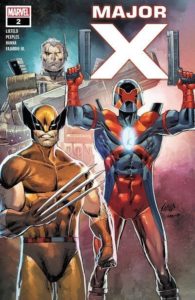 “died,” just yet. Meet The Skrulls continues to be a clever take on TV’s The Americans, but with shape-shifting alien spies instead of Russians; the reader disconnect in rooting for the “bad guys,” plus Niko Henrichon’s sleek art, make it worthwhile, especially as just a five-issue mini-series. Major X‘s second issue is not drawn by Rob Liefeld — probably a good thing, if his stiff-figured, weirdly-proportioned slapdash cover is any indication; if you loved his New Mutants or Image work back in the day, get this for nostalgia’s sake, but otherwise don’t be fooled by the
“died,” just yet. Meet The Skrulls continues to be a clever take on TV’s The Americans, but with shape-shifting alien spies instead of Russians; the reader disconnect in rooting for the “bad guys,” plus Niko Henrichon’s sleek art, make it worthwhile, especially as just a five-issue mini-series. Major X‘s second issue is not drawn by Rob Liefeld — probably a good thing, if his stiff-figured, weirdly-proportioned slapdash cover is any indication; if you loved his New Mutants or Image work back in the day, get this for nostalgia’s sake, but otherwise don’t be fooled by the 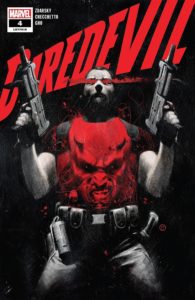 speculators: to the eyes of modern readers, this is not a good comic. Betcha five years from now its first issue, and this one, won’t be worth more than cover price. Daredevil’s worth a look for its reinvention of the character, more vulnerable than ever and with a new police-detective adversary, and for showing the consequences of violence more grimly than superhero comics usually do. If you loved the Mark Waid/Chris Samnee happy-go-lucky version, this probably won’t appeal — but writer Chip Zdarsky seems to be going somewhere with it, and hopefully will end with Matt Murdock in a better place; he’s got me continuing to read it and wondering what’s going to happen next, at any rate….
speculators: to the eyes of modern readers, this is not a good comic. Betcha five years from now its first issue, and this one, won’t be worth more than cover price. Daredevil’s worth a look for its reinvention of the character, more vulnerable than ever and with a new police-detective adversary, and for showing the consequences of violence more grimly than superhero comics usually do. If you loved the Mark Waid/Chris Samnee happy-go-lucky version, this probably won’t appeal — but writer Chip Zdarsky seems to be going somewhere with it, and hopefully will end with Matt Murdock in a better place; he’s got me continuing to read it and wondering what’s going to happen next, at any rate….



